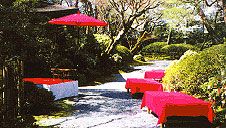HISTORY OF THE YABUNOUCHI FAMILY
|
The ancestor of the Yabunouchi family was in the service of the Shogun (The head of military government) "Ashikaga Yoshimasa" (1436-1490) for the Tea Ceremony and other arts.
|

|
The founder, "Yabunouchi Kenchu Jochi" (1536-1627) studied the Tea Ceremony with "Sen no Rikyu" (1522-1591) under "Takeno Jouou" (1502-1555) who introduced an artistic sensitivity for the tea utensils and the thought that emphasizes a simple, austere type of beauty and a serene mind. The founder formed the foundation of this art at its dawn with "Sen no Rikyu" and his brother in law, "Furuta Oribe" (1544-1615).
Among those great masters who served for the ruling class, "Yabunouchi Kenchu Jochi", the founder was in pursuit of the formal elegance of the original Tea Ceremony. When "Sen no Rikyu" started to serve for the ruler to host the visit of the Emperor, he entrusted the founder to enlighten the ordinary people. Although "Yabunouchi Kenchu Jochi" himself served to host the second visit of the Emperor for the ruler at his earnest request after the death of "Sen no Rikyu", he stepped down from the ruler's court at his own will. From that time on, the aristocrats, the high priests of Buddhism and the general public have entered the Yabunouchi School. In the days of the second head master, "Nishi-Honganji", one of the most influential Buddhism temples, invited him as its master for the Tea Ceremony and offered the land in Kyoto for him. The Yabunouchi family has settled there until today.
|
|
|

